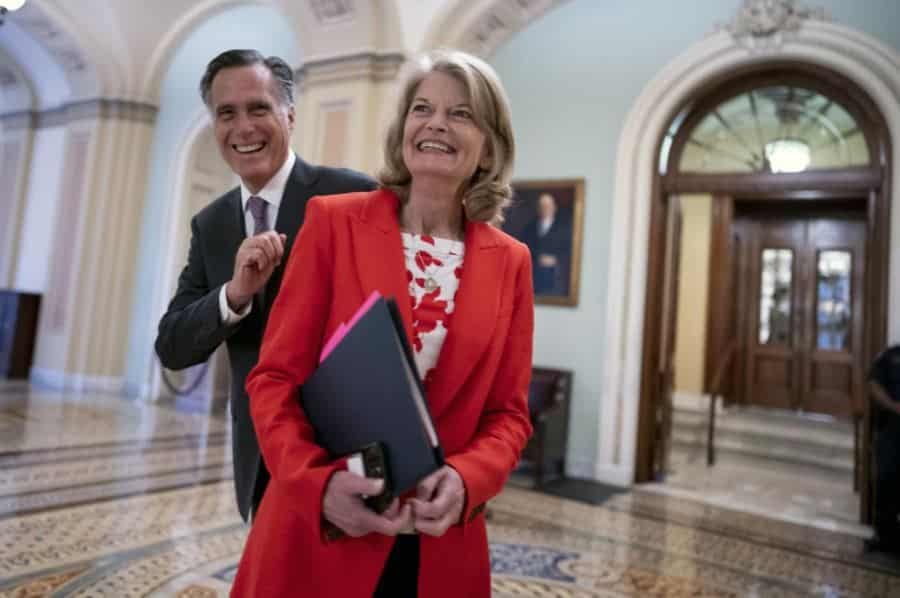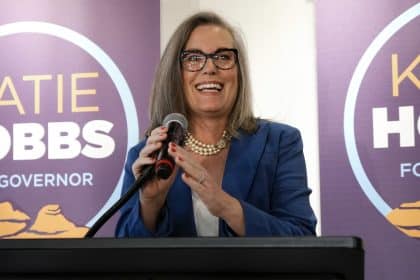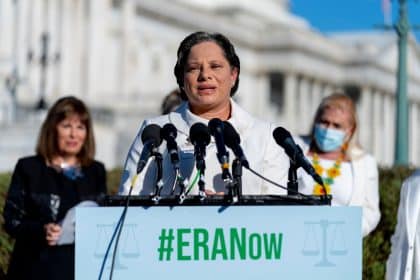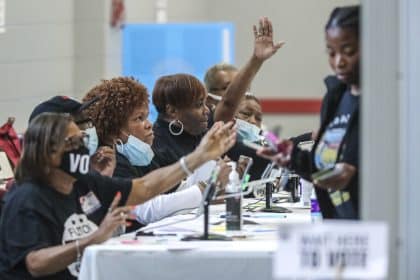Alaskans to Get First Taste of Ranked Choice Voting

WASHINGTON — Alaskans heading to the polls for the state’s primary election on Tuesday will get their first, limited exposure to ranked choice voting in a special House election taking place the same day, and featuring Republicans Sarah Palin and Nick Begich, and Democrat Mary Peltola.
When they arrive at the polls on Tuesday, voters will be given a two-sided ballot.
On the front, voters will be asked to choose just one of 17 candidates competing in the U.S. Senate primary, one of 22 candidates running in the U.S. House primary race, and their choices in the primaries for governor, lieutenant governor and state House and Senate seats.
The top four finishers for each primary will be placed on the ballot for the general election, which will take place in November.
On the back of the ballot, the voters will find the special election to fill the final months of Rep. Don Young’s unexpired term.
The Alaska Republican, who had held the state’s sole at-large seat in Congress for 49 years, died in March while on a flight from Los Angeles to Seattle.
There will be three candidates listed on side two of the ballot and voters will be asked to rank them, 1, 2 or 3.
Under ranked voting, ballots are counted in rounds. A candidate can win outright with more than 50% of the vote in the first round.
If no one hits that threshold, the candidate with the fewest votes is eliminated. Voters who chose that candidate as their top pick have their votes count for their next choice.
The rounds continue until two candidates remain, and whoever has the most votes wins.
Palin has already reportedly complained that the system is confusing. Former President Donald Trump, who has endorsed Palin, has called it, “rigged.”
In the meantime, a number of voting advocacy groups have taken creative steps to help voters better understand this year’s ballot, including one that put on a mock election featuring drag show performers.
Organizations have gotten creative in trying to help voters understand how to cast their ballot, as the mock election featuring drag performers shows.
Senate Race
The big race on the front side of the ballot is the one for the U.S. Senate featuring incumbent Republican Lisa Murkowski, Republican Party-endorsed Kelly Tshibaka or Democratic Party-endorsed Patricia Chesbro.
However, beyond the better known names in the race there are 14 other candidates on the ballot and political pundits in the state said almost any of them might come in fourth.
This is important because the top four candidates in Tuesday’s voting will advance to the November general election where all the races will be conducted using ranked choice voting.
Given the system in place, Murkowski is widely expected to get through to the November election, even if an expected backlash from her vote to impeach Trump keeps her from the top of the election night results.
That spot, the smart money says, will likely go to Kelly Tshibaka, a former state administration commissioner, who won the state party’s endorsement after it censured Murkowski for her impeachment vote.
Tshibaka has mounted an aggressive challenge to Murkowski, but she’s also seen as having something of a ceiling, opening the door to the incumbent “losing” on Tuesday, but ultimately getting enough of the ranked votes in November to hold onto her seat.
Also Murkowski has a significant financial edge. As of late July, her campaign still had $5.3 million in the bank; Tshibaka had $808,000.
According to AdImpact, Murkowski herself has spent nearly $1.1 million on TV ads for the primary, while a super PAC, Alaskans for Lisa, has spent $1.2 million on advertising. Tshibaka has spent just $174,000.
The other thing to watch in this primary contest is when it will be called. Absentee and military ballots have to be postmarked by election day, but have a 15-day window to arrive at the board of elections, meaning in an especially tight race Tuesday night, it could be two weeks before the winner is decided.
As for the Democrats, retired teacher Patricia Chesbro is considered likely to come in third, but former Seward, Alaska, Mayor Edgar Blatchford also has a real shot.
Two other candidates in the race are Army veteran Sean Thorne, who is running as a Libertarian, and the Alaskan Independence Party’s Dustin Darden, an anti-vax conspiracy theorist.
House Race
A special open June primary for Alaska’s at-large congressional district winnowed a 48 contender field down to just four top vote getters.
Independent Al Gross has since dropped out of the race, leaving only Palin, Begich and Peltola in the race.
For Palin the race for the congressional seat marks her first campaign for elected office since she resigned as governor in 2009.
Prior to that, of course, she was the vice presidential candidate on the 2008 Republican presidential ticket alongside then-Sen. John McCain of Arizona.
But published reports suggest this time, she’s mainly been focused on fundraising out of state and hasn’t really done much in the way of retail campaigning.
In a statement released after she decided not to participate in a candidate forum hosted by two local chambers of commerce, her campaign manager, Kris Perry, said “Sarah Palin is Alaska’s ambassador, and her ability to leverage existing relationships with influential leaders from all over the country is one of the main reasons she is ready to hit the ground running.”
Begich is the grandson of Democrat Nick Begich, Sr., who represented Alaska in Congress until he disappeared in a plane crash in 1972.
He is also the nephew of former U.S. Sen. Mark Begich and current state Sen. Tom Begich, both Democrats.
In fact Begich, the founder of a software development company, has said one of his biggest challenges in the race is convincing voters he’s a true conservative Republican.
As for Peltola, the Democrat in the running, she served in the Alaska legislature for nearly a decade and if she won, she would be the first Alaskan Native American to be elected to Congress.
When Your Stars Line Up Just Right
It wasn’t all that long ago that Alaska’s incumbent Republican Gov. Mike Dunleavy looked to have a tough re-election race on his hands.
His poll numbers plummeted when he imposed tax cuts on state university and ferry system budgets, but he began to recover the public’s favor when he walked back both initiatives.
The rising price of gasoline even worked in his favor as higher oil prices helped balance the state’s budget.
But most significant is the impact the surging oil prices had on Alaska’s annual Permanent Fund Dividend.
The fund was created during the construction of the Trans-Alaska Pipeline in the early 1970s. Originally seen as a bonanza for the state, the legislature quickly plowed through the initial $900 million in lease money.
In 1976, Alaskans responded by voting to amend the constitution to put at least 25% of the oil revenues into a dedicated fund — the permanent fund to save money for future generations who would no longer have oil as a source of income.
Every year, Alaskans living in the state get an annual dividend payment, typically in late September to early October.
This year the payment is $3,200, the highest it has ever been.
Despite his seeming good fortune, Dunleavy is facing a determined challenger in former independent Gov. Bill Walker. Former State Rep. Les Gara is the frontrunner among Democrats.
Dan can be reached at [email protected] and at https://twitter.com/DanMcCue.
























